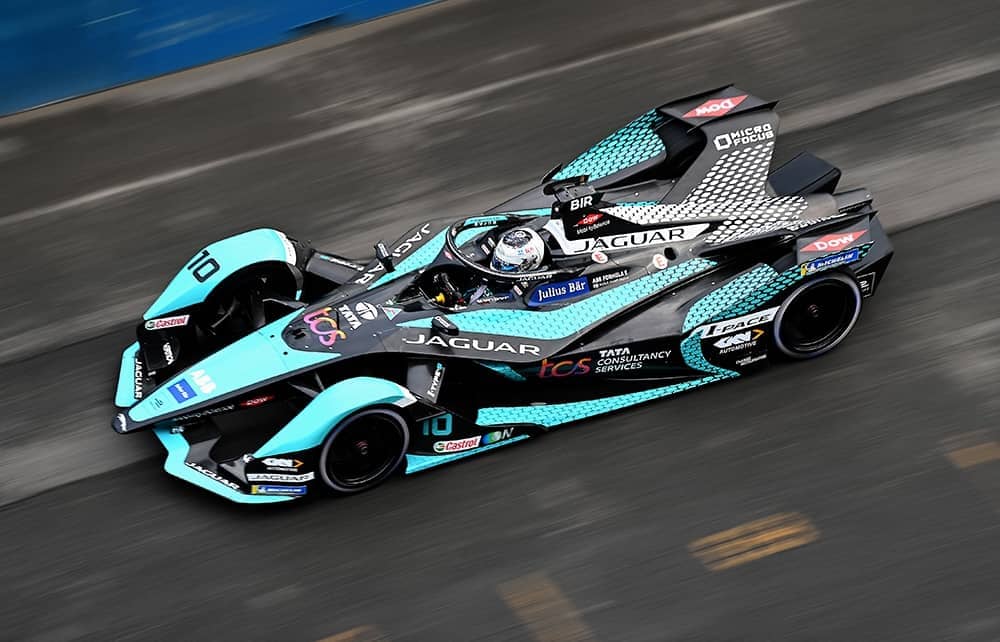Are petrolheads’ days numbered? I only ask because having just been introduced to the quiet, petrol-less world of Formula E, I’m rather taken by it. Apart from anything else, part of the fun of spectating is making your feelings heard, which isn’t easy against the 130 decibels generated by F1 engines.
The Formula E world championship arrives in London’s Docklands this weekend, weaving in and out of the ExCeL for races 13 and 14 of the season. That’s ‘E’ as in electric and plainly non-fossil fuel motoring is the future, though how soon isn’t clear. Formula E people think single-seat racing is a good way to promote it, and once you see a race you have to agree.
The cars are beautiful, and the whispering whizz of the tyres on the track is quite hypnotic
It’s every bit as thrilling as F1, often more so. The cars are beautiful, brilliantly driven, and the whispering whizz of the tyres on the track is quite hypnotic. Often nothing much happens in an F1 race with the drivers belting round in incident-free starting order until Lewis Hamilton or Max Verstappen swerves past the chequered flag a couple of hours later.
Formula E racing is like very fast go-karts going wheel to wheel on a tight track. The TV coverage is excellent and the whole production slick. The drivers are cool, with six Brits at ExCeL to get behind, and the crowds full of glamorous women with shades on their heads. As with any good race meeting there’s also a whole heap of razzamatazz. The races themselves last just over 45 minutes, the limit of battery power – quick enough to stop even your most tiresome family member getting bored.
And you might catch a repeat of the New York E-Prix double-header a few weeks ago. The concrete track was baking in 30-plus heat, punishing the all-weather tyres. A sudden flash downpour then soaked the course and left racers feeling they were driving blind. The two leaders, Nick Cassidy and Lucas di Grassi, aquaplaned into the wall at 100 kph. Former F1 driver Di Grassi said it was the biggest crash of his career, and he should know.
All the big manufacturers, from Mercedes to Porsche and Citroën to Jaguar, have teams in the championship, and will be joined next year by Maserati and McLaren. It’s pretty global too: in Jakarta E-racing pulled in a 12.5 million TV audience and in a couple of weeks the season finishes in Seoul. Next year they will be going to Sao Paulo. The makers all say the lessons they’re learning on the track will soon be applied to the road.
The challenge facing electric vehicles isn’t speed (they’re only a touch slower than F1) but range. The circuits are compact, full of turns and made for overtaking, and always built in an exciting spot. I saw a race in a specially created track at Berlin’s Tempelhof airport, a place built by the Nazis and steeped in history. You hope the Formula E circus will explore some of the traditional circuits, though the range would have to improve. Maybe you don’t care too much who wins – and building up the drivers has to be part of any Formula E strategy – but you will have plenty of fun watching who does. Do have a look this weekend.
The huge lawsuit launched by more than 180 brain-injured former rugby players could hit the game with the force of a Springbok ‘Bomb Squad’. Clearly rugby has only belatedly caught up with the dangers as players get bigger, stronger and fitter. Now there must be an existential threat hanging over the sport as we know it. It’s difficult to see how it can survive in its current form given society’s safety-first priorities so that, as happened round our way, kids’ paddling pools were closed on health and safety grounds – because it was too hot. Tinkering with the scrum and the clearout may be well-intentioned but smacks a bit of rearranging the deckchairs. Will the game still be recognisable in ten years? Somehow I doubt it.





Comments